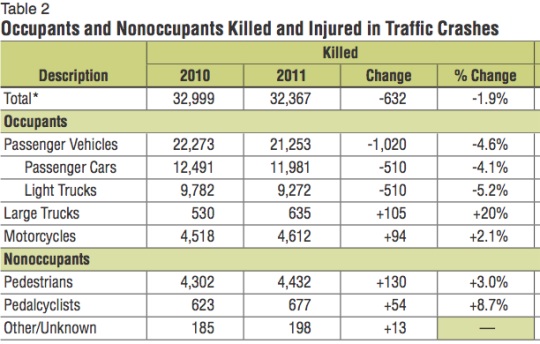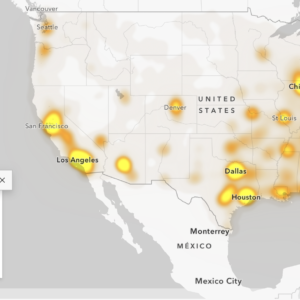New analysis of traffic collision data released today by the U.S. Department of Transportation’s National Highway Traffic Safety Administration (NHTSA) shows a decrease in overall fatalities from 2010 to 2011. However, in the “pedalcyclist” category (the strange word the feds use to describe people that are biking) there was an 8.7 percent increase.
The new analysis shows that overall, highway deaths fell to 32,367 in 2011, the lowest level since 1949 and 1.9 percent below 2010. This continues a downward trend in highway deaths in recent years.
A press release issued by the USDOT acknowledged that people drove 1.2 percent fewer miles in 2011 than 2011, but the drop in roadway deaths, “significantly outpaced” that decrease.

While fatalities declined for people in passenger cars and light trucks/SUVs, four other types of road users saw an increase in deaths. “Fatalities increased among large truck occupants (20 percent), pedalcyclists (8.7 percent), pedestrians (3.0 percent), and motorcycle riders (2.1 percent),” reads the release.
The NHTSA’s Fatality Analysis Reporting System (FARS) says 677 people died while bicycling in 2011. That’s up from 623 in 2010. This is a reversal of a significant downward trend in bicycling deaths. In 2005, FARS data shows that 786 people died while biking.
The NHTSA doesn’t offer any further analysis or information about the ‘pedalcyclist’ increase. However, the L.A. Times reported today that, “The NHTSA said 70% of all bicycle-related deaths involve head injuries but that barely one-third of cyclists wear helmets.”
A bit closer to home in Oregon, NHTSA data shows a 4.4 percent increase in overall fatalities from 2010 (317) to 2011 (331). The Oregon Department of Transportation recently reported that deaths to people walking on our roads were up significantly this year, from 42 in 2011 to 55 so far this year. On the bike side of things, there were 13 people killed in Oregon while biking in 2011 and 8 fatal collisions involving a someone on a bike so far this year. In Portland, we’ve had two people killed while biking in 2012.
Read more about the latest numbers and download the report via the NHTSA website.







Thanks for reading.
BikePortland has served this community with independent community journalism since 2005. We rely on subscriptions from readers like you to survive. Your financial support is vital in keeping this valuable resource alive and well.
Please subscribe today to strengthen and expand our work.
+ increase in distracted driving http://www.distraction.gov/
+ turnover/replacement of pre-airbag automobiles + lower VMT
those would be my hunches
What is the total number of cyclists for both years, along with vehicular traffic? If the overall amount has increased it could easily account for that increase in injuries and could still possibly mean less in comparison to total riders from years prior. The percentages should be disregarded in this report.
Except that fatalities for those on bikes have been declining alongside increasing ridership in recent years. A 23% jump in one year is huge.
I meant 8.7% of course, not 23%
No doubt it may be an increase but that 8.7% is not much in terms of numbers. So additional ridership if we knew those numbers could outweigh it along with showing maybe less aren’t actually being hurt in vehicles if the mode of transportation is switching from cars to bikes.
New York City had an 8% increase in the number of cyclists from 2010-2011. I would imagine many other communities saw the same, so an 8% rise in deaths (commensurate with the increase in cyclists) is expected. Also, this article from the UK suggests that the increase may be due in part to the recession: http://www.guardian.co.uk/lifeandstyle/2011/dec/27/cyclist-deaths-rise-recessions
there’s little incentive to drive better if the cars keep getting designed to better protect the occupants…
lifetime license revoke for causing any accident that requires somebody to seek medical attention…
What about reckless cyclists who cause accidents?
Presumably you mean “who cause accidents that injure others?” (otherwise you’re not speaking to the actual post) In both cases, the penalty should reflect the carelessness of the operator and the severity of the injuries. In most cases, this will result in more severe penalties for the operator of a motor vehicle, which are appropriate given the commensurate increased need for due care. The average motor vehicle is 10-20x the weight of a mounted bicycle and typically travels at twice the speed. Since that equates to 40-80x as much impact energy, it would seem like putting equal enforcement on cars and bikes makes as much sense as equal enforcement on a .44 Magnum and a BB pistol.
That’s so over the top. You might as well hand out death sentences if you’re going to hand out extreme penalties. I’m sorry, but your life is over. You can’t live where you do or work or even have the job you trained your whole life for. Sorry.
no car = life’s over?
heard of carhead?
Please type this 100 times, Marid:
Driving is a privilege, not a right.
Driving is a privilege, not a right.
…
Then type this 100 times:
Motor vehicles are deadly weapons.
Motor vehicles are deadly weapons.
…
When I took Drivers Ed, long long ago in a state far, far away, these two lessons were THE first things we were taught before we started digging into the rules of the road, and they were drilled into our heads over and over again. Sorry you either slept through class Marid, or decided to goof off in the back of class, or maybe grew up in in a state like Oregon that didn’t require Drivers Ed. But the lessons still apply, and ignorance is no excuse.
Spiffy’s solution is more extreme than I’d go, but I have no sympathy for your counter-argument. If you’ve structured your life in such a way that you can’t survive without driving, and you go and do something irresponsible that causes you to lose your driving privileges, well too bad. And if you kill someone by wielding your deadly transportation weapon carelessly, you should be off to prison – where you won’t be using your driving privileges anyway.
“What about reckless cyclists who cause accidents?”
Yes, what about those unicorn cyclists who kill people? Let’s see, in many years of cycling I have heard of exactly one incident in which a cyclist killed someone in the northwest: a woman died after being struck by a cyclist on the Burke-Gilman trail in Seattle a number of years ago. I don’t know the specifics of that case, but if the cyclist was at fault then of course he should have been charged under Washington’s vehicular homicide law.
Meanwhile, thousands of motorists kill people through carelessness or recklessness, often with no legal consequences whatsoever.
…and law enforcement interprets laws in ways that continue favoring those inside automobiles at the expense of those outside of them.
ban seat-belts and airbags and people will be more careful…
“A press release issued by the USDOT acknowledged that people drove 1.2 percent fewer miles in 2011 than 2011, but the drop in roadway deaths, “significantly outpaced” that decrease.” According to the Traffic Safety Facts (http://1.usa.gov/SMB0s9) to which the press release refers, Figure 2, makes it clear that the injury rate per vehicle mile traveled (VMT) has been flat, or perhaps slightly increasing, for three years. Not declining.
That is interesting, but the overall trend for at least the last couple of decades has been a decrease in total fatalities for (I think) all modes, even as driving (and more recently biking) have increased. The fact that some of these fatality statistics are reversing is not only troubling, the apparent asymmetry of the reversal is deplorable.
Or that the decreases over those decades were -1 Sigma variations (randomly slightly better than average) and our luck is catching up with us.
Short of thorough driver education I’m not sure anything can change the fundamental carelessness of the average human. Any safety improvements that prove to be effective would be my prior suggestion or engineering solutions that remove the ability of drivers to cause damage while being careless.
LA Times perpetuates the notion that anyone riding without a helmet deserves to die.
What about all those pedestrians? I bet even fewer than 1/3 of them were wearing helmets.
“The NHTSA said 70% of all bicycle-related deaths involve head injuries but that barely one-third of cyclists wear helmets”.
Um, that’s an interesting & potentially misleading statement by NHTSA. What’s missing is: of the head injury deaths, how many cyclists were wearing helmets? Then we’d start to be a-knowin’ somethin. Or maybe it’s just a typo or a misquote, but something is really askew with that statement.
While i do take it pretty much on faith that helmets can reduce head injuries, I’m not so convinced that they can radically (magically?) decrease fatalities.
But I’m open to persuasion, so convince me. But you’ll have to better than this vacuous NHTSA statement.
NHTSA needs to be called to task on this “ScArY StAt!”.
It has been well established that there is no consistent, often no, collection of data from collisions that involve bicycles.
Therefore: NHTSA has no scientific basis upon which to support the above supposition.
You pretty much have to take it on faith, since helmet testing is inconsistent and only tests for certain types of head blows (I’ve heard many only test for impacts on the crown of the head, not the sides, which you’re probably more likely to hit). And they’re supposedly designed to protect against only the most traumatic injuries, like cracking your skull open, not designed or tested for protecting against concussions that can cause life-long problems, too. And your face is always unprotected. We need better ways to protect cyclists than telling them to wear a helmet.
OK, I’m done with my helmet bashing for today.
If you want to bash helmets do it in the language of statistics.
They toss out a nice precise number of head injuries (70%) then pair it with the statisticians bane: imprecision – that vague statement about the “barely one third of cyclists”.
They are attempting to analyze a sub set (cyclists who received head injuries) with the main set (all cyclists) data and are doing it with fake numbers.
For it to make any real difference we need to know the portion of cyclists head injuries that both with and without helmets.
The NHTSA’s use of “barely a third” is their tacit admission that they do not have the data to factually back up their irrational fear of cyclists but aren’t going to let that get in the way of fear mongering.
How about “Cyclists without helmets triple their chance of death by head injury”?
http://www.thestar.com/news/gta/article/1271695–cyclists-without-helmets-three-times-more-likely-to-die-of-head-injuries
It’s clear a lot of you consider your hair more important than your brains, so go on with your bad helmetless selves.
How many motorists were wearing helmets? I’m sure those numbers would go down with helmet laws as well.
With more information like riders ages etc, most this information does little more than tell you that – even without a helmet cycling- is by far the safest way to travel.
I’m willing to bet that most the increase is due to the fact that many cities are starting to add bicycling to “the plan” and the local drivers haven’t adjusted for it yet. And that more established bicycle cities like ours are seeing large decreases (like our nearly 30% locally).
After all the biggest effect on bicycle safety in a community isn’t helmet laws or bike lanes etc, it’s the number of cyclists.
Pedalcyclist <=> Motorcyclist
As far as highway engineers are concerned we are all two wheeled interlopers.
Bureaucratic classification schemes are some of the few things to survive revolutions, bloody coups and epoch time itself. I’m not sure this is one worth fighting until the human race evolves in to energy beings with no physical form.
RIP Dustin Finney, 2011 statistic and real person.